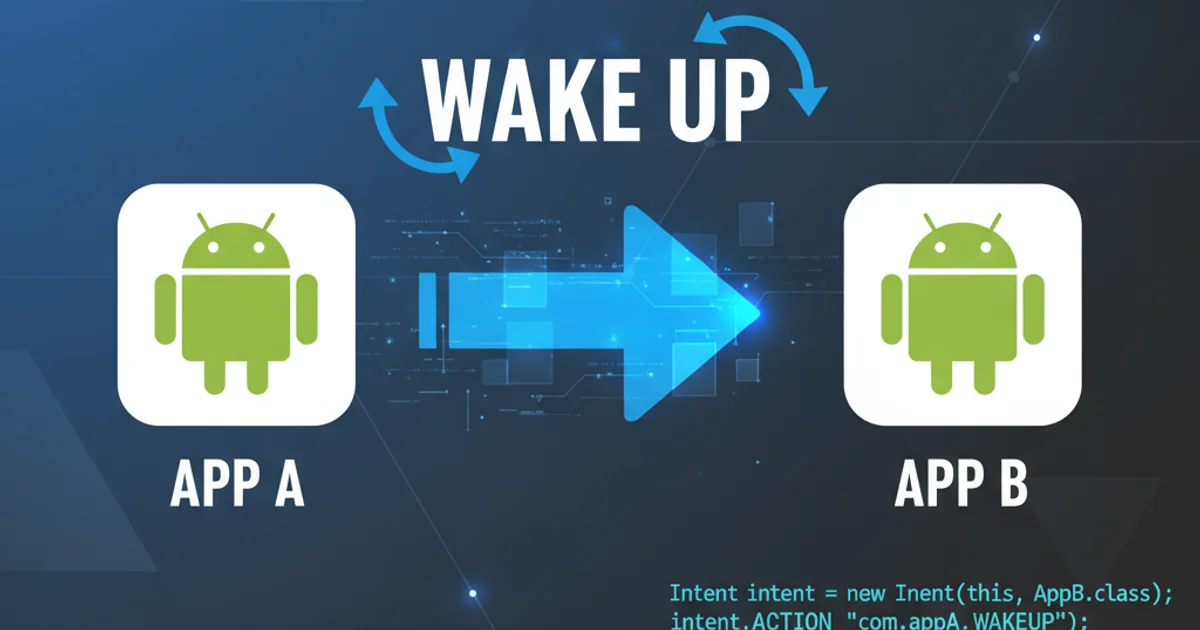How to wake up another Android app?
Categories:
How to Wake Up Another Android App: Techniques and Best Practices

Learn various methods to programmatically launch or bring another Android application to the foreground, understanding the implications and best practices for inter-app communication.
Inter-app communication is a fundamental aspect of the Android ecosystem, allowing applications to interact and share functionalities. One common requirement is for one Android app to 'wake up' or launch another. This article explores the primary methods for achieving this, focusing on Intents, their configurations, and the necessary permissions. We'll also discuss best practices to ensure a smooth user experience and maintain system stability.
Using Explicit Intents to Launch a Specific App
The most straightforward way to wake up another Android app is by using an explicit Intent. An explicit Intent specifies the exact component (e.g., a specific Activity) that should handle the action. This method is ideal when you know the package name and the target Activity class of the app you want to launch.
import android.content.Intent
import android.content.ComponentName
fun launchSpecificApp(packageName: String, activityClassName: String) {
val intent = Intent().apply {
component = ComponentName(packageName, activityClassName)
// Optional: Add flags to clear the activity stack or create a new task
// addFlags(Intent.FLAG_ACTIVITY_NEW_TASK)
// addFlags(Intent.FLAG_ACTIVITY_CLEAR_TASK)
}
try {
startActivity(intent)
} catch (e: Exception) {
// Handle cases where the app or activity might not be found
Log.e("AppLauncher", "Could not launch app: ${e.message}")
}
}
Kotlin code to launch a specific app using an explicit Intent.
FLAG_ACTIVITY_NEW_TASK, ensure your calling context is an Activity or that you add FLAG_ACTIVITY_NEW_TASK to the Intent if calling from a Context other than an Activity (e.g., a Service). This is crucial to prevent a BadTokenException.Using Implicit Intents for Flexible App Interaction
Implicit Intents are used when you want to perform an action (e.g., view a webpage, send an email, share content) but don't know which specific app will handle it. The Android system then finds the best available app to fulfill the request. This is a more flexible approach and is often preferred for common actions, as it allows the user to choose their preferred app or for the system to select a default.
import android.content.Intent;
import android.net.Uri;
public void launchAppImplicitly() {
// Example: Launching a web browser
String url = "https://www.example.com";
Intent browserIntent = new Intent(Intent.ACTION_VIEW, Uri.parse(url));
// Verify that the intent will resolve to an activity
if (browserIntent.resolveActivity(getPackageManager()) != null) {
startActivity(browserIntent);
} else {
// Handle case where no app can handle the intent
Log.e("AppLauncher", "No app found to handle web URL.");
}
// Example: Launching another app via a custom scheme (if defined by the target app)
// Intent customSchemeIntent = new Intent(Intent.ACTION_VIEW, Uri.parse("myapp://open/data"));
// if (customSchemeIntent.resolveActivity(getPackageManager()) != null) {
// startActivity(customSchemeIntent);
// } else {
// Log.e("AppLauncher", "No app found for custom scheme.");
// }
}
Java code demonstrating implicit Intent usage to open a web browser.
flowchart TD
A[Calling App] --> B{Create Intent}
B -- Explicit Intent --> C{Target App Package/Activity}
B -- Implicit Intent --> D{Action/Data URI}
C --> E[Android System]
D --> E
E -- Resolves Intent --> F[Target App]
F --> G[Target App Launched/Foregrounded]Flowchart illustrating how Intents are resolved by the Android system to launch target applications.
Handling Permissions and App Availability
When attempting to launch another app, especially using explicit Intents, it's crucial to consider app availability and permissions. If the target app is not installed, or if its components are not exported or require specific permissions, your launch attempt might fail. Always include error handling and consider informing the user if an app cannot be launched.
<!-- In your AndroidManifest.xml, if you need to query for specific packages -->
<manifest xmlns:android="http://schemas.android.com/apk/res/android"
package="com.example.myapp">
<queries>
<!-- If you explicitly launch a specific app by package name -->
<package android:name="com.example.targetapp" />
<!-- If you query for apps that can handle a specific intent action/category -->
<intent>
<action android:name="android.intent.action.VIEW" />
<category android:name="android.intent.category.BROWSABLE" />
<data android:scheme="https" />
</intent>
</queries>
<!-- Other manifest elements -->
</manifest>
Example of <queries> element in AndroidManifest.xml for package visibility.
<queries> element in their AndroidManifest.xml. Without this, your app might not be able to see or launch other apps, even if they are installed.1. Define Your Goal
Determine if you need to launch a specific app (explicit Intent) or perform a general action (implicit Intent).
2. Construct the Intent
Create an Intent object, specifying the component for explicit Intents or the action/data for implicit Intents.
3. Add Necessary Flags (Optional)
Include Intent flags like FLAG_ACTIVITY_NEW_TASK or FLAG_ACTIVITY_CLEAR_TOP as needed for desired behavior.
4. Check App Availability
Before calling startActivity(), verify that an app can handle the Intent using resolveActivity() to prevent ActivityNotFoundException.
5. Declare Package Visibility (Android 11+)
If targeting API 30 or higher, add appropriate <queries> elements to your AndroidManifest.xml.
6. Execute the Intent
Call startActivity(intent) from your Context (typically an Activity).
7. Handle Exceptions
Wrap startActivity() in a try-catch block to gracefully handle ActivityNotFoundException or other potential issues.